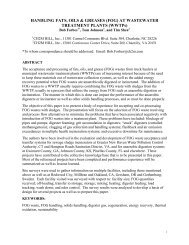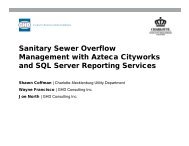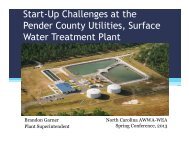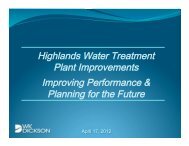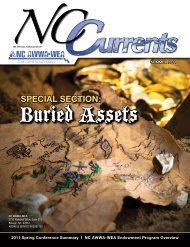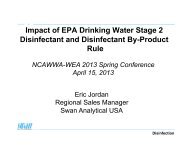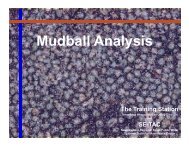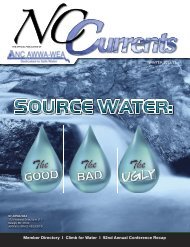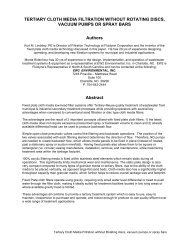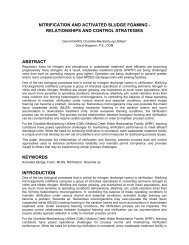GRIT HAPPENS â YOU DON'T KNOW WHAT YOU ARE MISSING
GRIT HAPPENS â YOU DON'T KNOW WHAT YOU ARE MISSING
GRIT HAPPENS â YOU DON'T KNOW WHAT YOU ARE MISSING
- No tags were found...
You also want an ePaper? Increase the reach of your titles
YUMPU automatically turns print PDFs into web optimized ePapers that Google loves.
TABLE 1. SPECIFIC GRAVITY OF LIKELY CONSTITUENTS OF <strong>GRIT</strong> (Reade Advanced Materials,2010)Specific Gravity of Various MaterialsQuartz Sand 1.2 Earth 1.4Limestone 1.55 Granite 1.65Clay 1.8 Red Brick 1.9Sand, wet 1.92 Gravel 2Asphalt 2.2 Concrete 2.4There is evidence that industry acceptance of this data is growing. For example, at the East Bay MUDwastewater treatment plant in the Oakland, California area it was determined that the specific gravity oftheir influent grit ranged from 1.04-1.61 with an average of 1.35 (Borys, Gabb and Hake, 2002).Illustrating the impact of this, a 210 µm particle with a specific gravity of 2.65 would settle at 2.39 cm/s at15ºC (59ºF); whereas a 210 µm particle with a specific gravity of 1.35 would settle at a rate of 0.62 cm/sat the same temperature. The difference is significant, with the higher specific gravity particle settlingalmost four times more rapidly than the other particle. This is an important fact considering thatconventional grit collection devices predominately rely on gravity as the main acceleration force causingseparation of the solids from the liquid stream.ShapeGrit particles vary in shape, are rarely spheres and many plants have noted that much of their larger gritis flat. An angular particle will exhibit reduced settling characteristics, settling more slowly than a sphereas its drag coefficient is higher (Jimimez and Madsen, 2003). More conservative design settling rates canbetter ensure capture of such angular particles.AgglomerationWhile in the collection system, the grit particles are exposed to a variety of constituents including fats, oils& greases (FOG), soaps, scum, some chemical constituents and dissolved gasses can attach to the gritparticles and alter the particles’ settling characteristics. Such wastewater constituents can be significantlyinfluenced by the commercial and industrial influences within the collection system. Regional aspects,such as the local soils and geology, winter traction control regimes and the type and age of the collectionsystem can also impact the nature of grit.Wet WeatherDuring peak wet weather events grit volume entering the plant can be 20-40+ times higher depending onthe peak to average flow ratio, as well as the age and type of collection system (Wilson, Tchobanoglous,Griffiths, 2007). As much as 70% of the annual grit load can be received at the plant during a handful offirst flush events (Wilson, 1998). These peak grit production periods frequently overload facilities, andmust also be accounted for in the design of a grit removal system, especially in terms of grit conveyanceand transport systems.<strong>GRIT</strong> SAMPLINGGrit size distribution and settling velocity is not easy to characterize. First, there is no industry standardmethod for measuring grit. Obtaining representative and repeatable samples is difficult because grit doesnot flow evenly into the plant. It tends to travel in a higher concentration at the bottom of the channel,volume fluctuates with diurnal flow variations and grit volume significantly increases during wet weatherevents according to the energy/velocity profile in the collection system. Due to these significant variationssampling should occur over several days and ideally also include a wet weather event.Care must be taken in collecting the sample to ensure it is representative of incoming grit. Sampling froma column of flow or well mixed area ensures a representative sample is collected. A sufficient amount ofmaterial must be collected for analysis and collected grit volume should be correlated to incoming flow soan inlet concentration can be determined, indicating whether the sample is representative. Whilecollecting grit, the holding vessel must be quiescent, encourage collected grit to settle and operate with aGrit Happens – You Don’t Know What You Are Missing




